Please Take Note: This is a review of the final game, but it might change slightly based on the success of the Kickstarter campaign. The game is being reviewed on the components and the rules provided with the understanding that “what you see is not what you might get” when the game is published. If you like what you read and want to learn more, we encourage you to visit the game’s website or the game’s Kickstarter campaign. Now that we have all that disclaimer junk out of the way, on with the review.
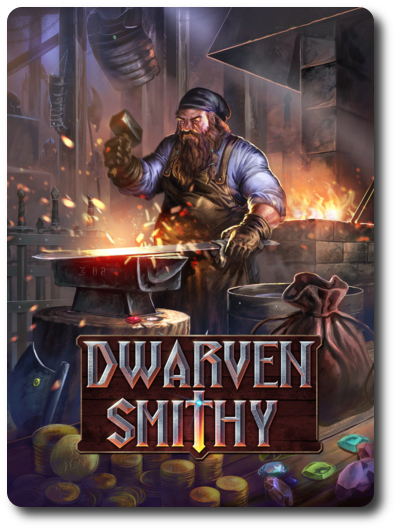
The Basics:
- For ages 12 and up (publisher suggests 14+)
- For 2 to 4 players
- Approximately 90 minutes to complete
Geek Skills:
- Active Listening & Communication
- Counting & Math
- Logical & Critical Decision Making
- Reading
- Strategy & Tactics
- Hand/Resource Management
- Auctioning, Bidding, & Trading
Learning Curve:
- Child – Easy
- Adult – Easy
Theme & Narrative:
- Master the forge and clear the mine to create objects of splendor and wealth!
Endorsements:
- Gamer Geek approved!
- Parent Geek approved!
- Child Geek mixed!
Overview
A typical “fantasy dwarf” is a master craftsman, a highly skilled miner, a legendary drinker, and a tough-as-nails fighter. In this game, players will test their crafting and mining skills against other dwarves to determine who is truly the master of the forge. Drinking and fighting will, of course, soon follow.
Dwarven Smithy, designed by Mike Warth and to be published by Flatworks Gaming, will reportedly be comprised of 78 Guild cards, 116 Resource cards, 8 Player cards, 1 Warehouse card, 80 Coin tokens (in the values of 1, 5, 25, and 100), 4 Icon reference cards, and 4 Player Turn/Scoring cards. Our copy also came with a game board that helped organize the cards, but this game component might or might not be included in the published version of the game. As this is a review of a prepublished game, I cannot comment on the game component quality. The provided artwork, by artists Enggar Adirasa, Leonardo Borazio, and Nick Deligaris, keeps with the game’s theme strong, furthering the narrative beautifully.
Setting Up the Forge
Note: Dwarven Smithy can be played using two different methods. The first and suggested method is the “Starter Game”, where the basic game play is introduced. The second method is the “Full Game”, which removes the introductory cards. Both methods of play are “complete”, with the only difference being a higher level of complexity. The game play and game setup described here is the Starter Game (since that is most likely every new player’s first attempt at Dwarven Smithy). A summary of the Full Game is provided in the Game Variant section.
To set up the game, first set aside the Icon, Player, and Player Turn/Scoring cards. These will be passed out at the end of game setup and as needed. Separate the Player, Guild, and Resource cards at this time, as well.
Second, search through the Guild cards and remove the Full Game cards, placing them back in the game box. Or, if playing the Full Game, remove the 16 starting cards instead. Shuffle the remaining Guild cards to form the Guild draw deck. Place the Guild draw deck face-down in the playing area.
Third, shuffle the Resource cards to create the Mine draw deck. Place the Mine draw deck face-down next to the Guild draw deck.
Fourth, give each player 15 gold coins worth of Coin tokens, placing the rest in a pile off to one side of the game playing area. I highly suggest you appoint one player to be the “Banker” to help make change as needed.
Fifth, each player receives 1 Player card, 4 Mine cards, and 2 Guild cards at random. The Player card is placed in front of the player, face-up. The Guild and Resource cards go in the player’s hand and should remain hidden until played.
That’s it for game set up. Determine who will go first and begin.
The Tools of the Trade
Dwarven Smithy uses a small number of cards to represent the materials and skills necessary to craft at the forge. These cards are summarized here.
Player Cards
The Player cards are as much a reference tool as it is a workbench. The Player card uses its four borders to represent four different areas of interest to the player. These are “Market”, “Apprentice”, “Tool”, and “Workshop”. Icons are displayed on the card that are used to quickly reference what actions can be performed in each area, as well as the general number of cards limited to each area.
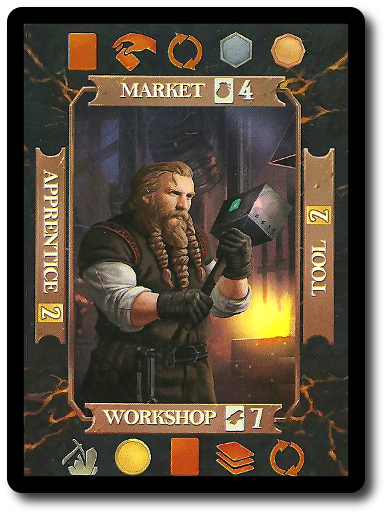
Guild Cards
The Guild cards represent the different craftsman the player will control (“Apprentices”), the “Tools” they will use, the “Items” they will craft, and special items requested by the king which are referred to as the “King’s Items”. The “Apprentice” Guild cards alter the base rules of the game, allowing the player to craft their own strategy and tactics, as well as altering them as the game progresses. “Apprentice” cards list the resource cost, buy value, card type, and special rules that may apply to the card itself.

The “Tools” Guild cards can be sold to the Bank for Coins or used to help craft additional items by reducing the necessary resource cost found on Guild cards. “Tools” Guild cards list the resource cost, buy value, the value it’s worth, and special rules that may apply to the card itself.
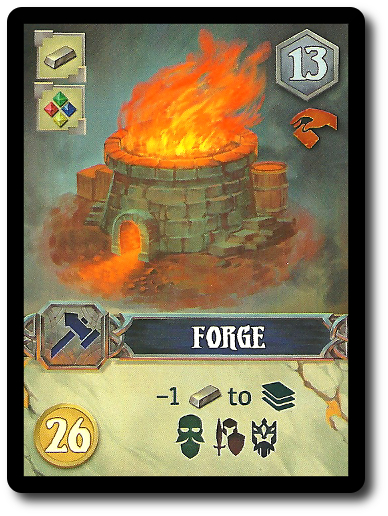
The “Items” Guild cards must be crafted and can then be sold to the Bank. “Items” Guild cards list the resource cost, the buy value, the value it’s worth, and special rules that may apply to the card itself.
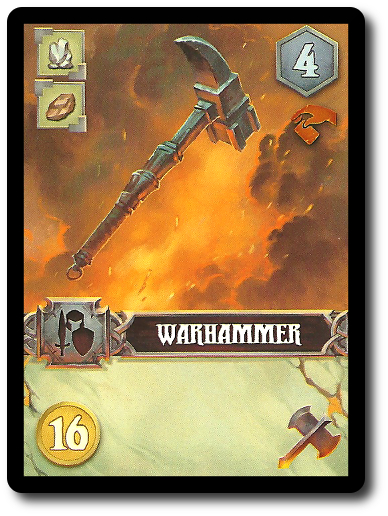
The “King’s Items” Guild cards are just like “Items” Guild cards, but are worth much more and are secretly built by the player. Once they are crafted, they remain hidden until finally revealed at the end of the game. “King’s Items” Guild cards list the resource cost, buy value, the value it’s worth, and special rules that may apply to the card itself.
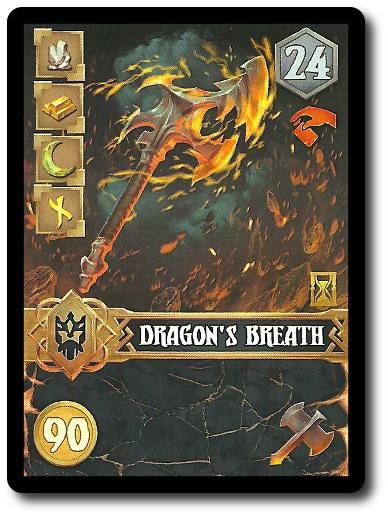
Resource Cards
The Resource cards represent the materials found in the mines. These are “Mithril”, “Gold”, “Silver”, “Iron”, “Emerald”, “Ruby”, “Sapphire”, “Moongem”, “Thunder Runestone”, “Lighting Runestone”, “Frost Runestone”, and “Earth Runestone”. These resources are in turn used to craft “Tools”, “Items”, and “King’s Items”. Resource cards list the resource icon, the buy value, and the sell value.
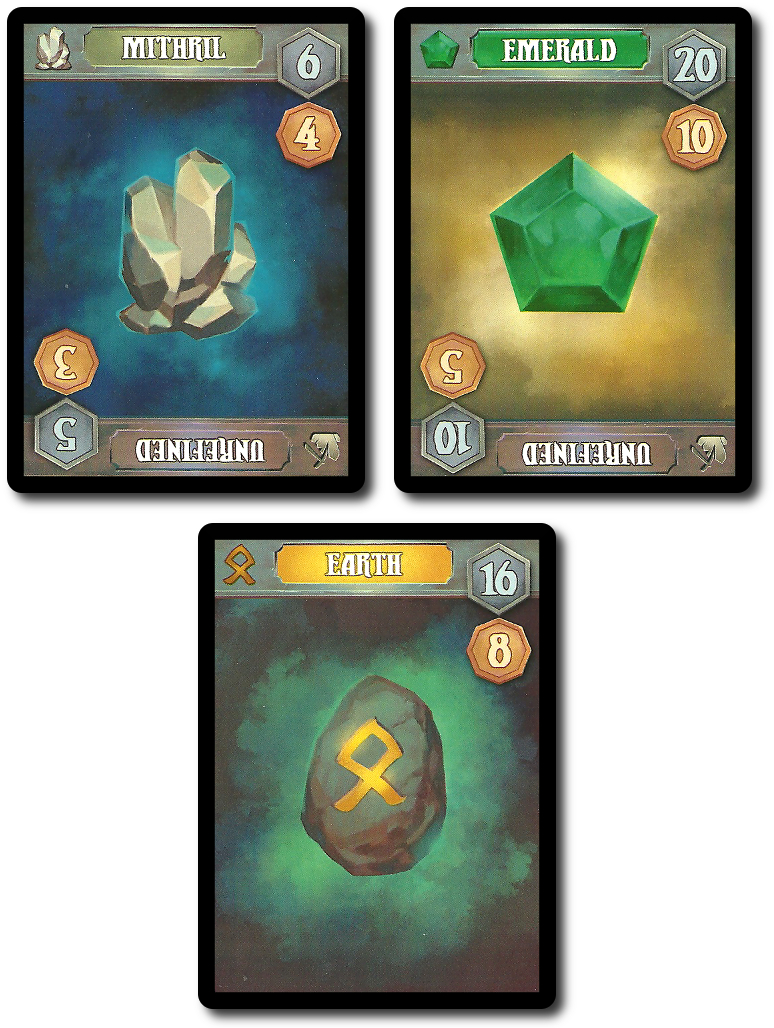
Mastering the Forge
Dwarven Smithy is played in rounds, turns, and phases. A summary of a typical game turn is provided here.
Refine Phase
When some resources are collected from the Mine draw deck and played, they start out as “unrefined”. A player may now refine any unrefined resources in the player’s Workshop by simply rotating it 180 degrees. When a resource is refined, its buy and sell values increase.
Complete Phase
Any Guild cards that were created during the player’s last turn can now be collected.
- “Apprentice” Guild cards are placed in the Player card’s “Apprentice” area and the Resource cards used are discarded. The text on the “Apprentice” Guild card is immediately considered “active” and should be resolved if necessary before the player continues their turn. There is a limit of two completed “Apprentice” Guild cards per Player card.
- “Tools” Guild cards are placed either in the “Tools” area or sold to the Bank. Once Tools are played to the “Tool” area, they cannot be removed. Resource cards used are discarded. There is a limit of two completed “Tools” Guild cards per Player card.
- “Items” Guild cards are sold to the Bank after the Resource cards are discarded.
- “King’s Items” Guild cards and any attached Resources are considered “one card” during the game. Once completed, all the cards are placed face-down in a single stack and then moved to the player’s “Market” area.
Action Phase
A player has access to seven possible actions during their turn that they can take as many times as they like, but they must be completed in sequential order. For example, a player could “Play a Card” 3 times in a row and then take “Move or Swap a Card”. The actions are as follows:
- Play a Card: Guild and Resource cards are played face-up from the player’s hand either to the “Market” or the “Workshop” areas. All cards played to the “Market” area are tilted 180 degrees and are considered “unrefined”.
- Move or Swap a Card: Cards in the “Market” and in the “Workshop” areas can be swapped or moved. Cards moved or swapped are tilted in the “Market” area.
- Discard a Guild Card from the Market: A single, non-tilted card in the “Market” area, can be sent to the discard pile.
- Sell a Resource Card to the Warehouse: A single, non-tilted card in the “Market” area can be sold for its Coin value. The Resource card is added to the Bank’s “Warehouse” area where it can be purchased by other players as required.
- Buy a Resource Card from the Warehouse: A single card is purchased from the Bank’s “Warehouse” area for the noted Coin value. Purchased card are added to the player’s hand.
- Buy a Card from Another Market: A single card is purchased from any opponent’s “Market” area as long as the card is face-up. Purchased cards from another opponent’s “Market” area must be placed in the player’s “Market” or “Workshop” area. Cards moved to the player’s “Market” area are tilted. Refined resources remain refined. The opponent receives the Coin value and adds it to their own pool of coins.
- Craft or Hire a Guild Card: Move the necessary Resource cards and the card to be crafted or hired to the player’s “Workshop” area, combing them into a single stack. If the card to be crafted is a “King’s Item” Guild card, keep it face-down. These cards will be hired or crafted on the player’s next turn.
Draw Phase
The player now draws a total of 4 cards from either the Guild draw deck or the Mine draw deck, but the total number of cards added to their hand cannot exceed the player’s current hand size limit. The player then untilts any tilted “Market” area cards. The player’s turn is now over and the next player in turn order sequence now takes their turn starting with the Refine Phase noted above.
Cooling the Forges
The endgame is triggered when a player draws the last Guild card on their turn from the Guild draw deck, draws the last Resource card from the Mine draw deck, or a player completes their turn with a total of four or more “King’s Items” Guild cards completed. Any players who have not taken their turn for the round may now take their final turn. When all players have completed their turn for the round, the game comes to an end.
Forging Victory
To determine who won the game, all players first discard all the cards still in their hand and all cards currently in the “Workshop” area. Players also discard all Guild cards in their “Market” area. Each player, in turn order sequence, now sells to the Bank all their Resource cards in their “Market” area for the listed Buy (yes, “buy”, not “sell”) value, which are then discarded.
Then all players reveal any completed “King’s Items” Guild cards, comparing them to determine which has the highest completed value for each sub-type (armor, weapons, etc.). The player with the highest receives a number of Coin tokens worth 25 gold for a total of no more than 75 gold. Then all players who completed one or more “King’s Items” Guild cards receive the value of each item in Coin tokens, discarding them once paid for.
Finally, all players now add up all their collected Coin token values. The player with the most gold wins!
Game Variants
Starter vs. Full Game
There really isn’t much of a difference regarding game play when it comes to the two different methods. What is different is the overall “recipe” complexity for the cards and their abilities. The Starter game method is perfect for teaching the game and for lighter games with a more casual feel. The Full game method, which takes longer, will challenge the players a good deal more in the areas of resource management and hand management.
Bidding
Instead of allowing players to purchase cards from an opponent’s “Market” area for the listed value, the bidding game rule variant invites bidding wars, ensuring that all players have the option to claim necessary cards to further their own goals even if it isn’t their turn. For a price. Bidding goes in turn order sequence, where players must bid a higher value than the previous stated bid or pass. The player with the highest bid claims the card and pays the bid amount to the opponent who is selling it.
Never Ending Story Mine
The endgame trigger for a depleted Mine draw deck can be removed from play by simply shuffling the discarded Resource cards to create a new Mine draw deck. The other endgame triggers are still in effect.
To learn more about Dwarven Smithy, visit the game’s website or the game’s Kickstarter campaign.
Final Word
 The Child Geeks were a bit mixed when it came to this game. The game’s complexity wasn’t the issue. What caused our Child Geeks to shy away from the game was the constant management of their cards, shifting them about for builds and sales. According to one Child Geek, “I like the game’s idea, but I don’t like how I have to keep moving cards around. It gets confusing and I forget what it is that I’m trying to do.” However, the older Child Geeks and those Child Geeks who are more than casual players found Dwarven Smithy to be a great deal of fun. According to one of these Child Geeks, “The best part of the game is the incredible amount of control you have over your turn. There’s a lot to think about, but the game gives you all the tools and actions you need to play and win.” What it came down to, endorsement-wise, was an individual player’s likes and dislikes when it came to how “busy” a game felt. Those Child Geeks who liked their games and turns to be fairly straightforward were turned off, while those Child Geeks who liked lots of room to maneuver and grow were very pleased. The end result was a mixed level of endorsement from the Child Geeks.
The Child Geeks were a bit mixed when it came to this game. The game’s complexity wasn’t the issue. What caused our Child Geeks to shy away from the game was the constant management of their cards, shifting them about for builds and sales. According to one Child Geek, “I like the game’s idea, but I don’t like how I have to keep moving cards around. It gets confusing and I forget what it is that I’m trying to do.” However, the older Child Geeks and those Child Geeks who are more than casual players found Dwarven Smithy to be a great deal of fun. According to one of these Child Geeks, “The best part of the game is the incredible amount of control you have over your turn. There’s a lot to think about, but the game gives you all the tools and actions you need to play and win.” What it came down to, endorsement-wise, was an individual player’s likes and dislikes when it came to how “busy” a game felt. Those Child Geeks who liked their games and turns to be fairly straightforward were turned off, while those Child Geeks who liked lots of room to maneuver and grow were very pleased. The end result was a mixed level of endorsement from the Child Geeks.
 The Parent Geeks, having more experience and an infinite amount of more patience, found Dwarven Smithy to be a delight. The two different game methods allow casual players and more hardcore players to both enjoy the same game with slight modifications to the overall game set up. This made the game highly accessible and compatible with different groups. According to one Parent Geek, “This game is challenging, light at times, heavier too, and always keeps players on task. I never felt lost, but I did feel a bit overwhelmed at times when it came to my turn. There never appears to be a bad action to take.” Very true! Hindsight is the greatest teacher, of course, but when a player is in the moment, everything looks like a good idea, thus reducing the level of stress, but increasing the length of time it takes a player to take their turn. As one Parent Geek put it, “The only thing I don’t like about this game is that takes just a bit too long to complete.” A true statement, but only when playing with opponents who are taking the game seriously or have no idea what they should do next. When the mine was cleared, the Parent Geeks voted to approve Dwarven Smithy.
The Parent Geeks, having more experience and an infinite amount of more patience, found Dwarven Smithy to be a delight. The two different game methods allow casual players and more hardcore players to both enjoy the same game with slight modifications to the overall game set up. This made the game highly accessible and compatible with different groups. According to one Parent Geek, “This game is challenging, light at times, heavier too, and always keeps players on task. I never felt lost, but I did feel a bit overwhelmed at times when it came to my turn. There never appears to be a bad action to take.” Very true! Hindsight is the greatest teacher, of course, but when a player is in the moment, everything looks like a good idea, thus reducing the level of stress, but increasing the length of time it takes a player to take their turn. As one Parent Geek put it, “The only thing I don’t like about this game is that takes just a bit too long to complete.” A true statement, but only when playing with opponents who are taking the game seriously or have no idea what they should do next. When the mine was cleared, the Parent Geeks voted to approve Dwarven Smithy.
 The Gamer Geeks had a lot of love for this game, finding the resource and hand management aspects to work well. The game provided deep game play and they always voted to use the “Bidding” game variant. What they didn’t like was the length of the game, finding it to overstay its welcome just a tad too long for their taste (actually, most casual players did, too). According to one Gamer Geek, “I think the game is solid, but it feels like it takes too long to complete. The longer you play, the more you feel like the game is just dragging itself out with no real benefit to show for it.” Another Gamer Geek said, “Good game. I think it would be a great addition to my gaming table and enjoyed by my group of players. Feels a bit light, but is actually pretty demanding.” When the Gamer Geeks had finished their last game, they all voted to approve Dwarven Smithy.
The Gamer Geeks had a lot of love for this game, finding the resource and hand management aspects to work well. The game provided deep game play and they always voted to use the “Bidding” game variant. What they didn’t like was the length of the game, finding it to overstay its welcome just a tad too long for their taste (actually, most casual players did, too). According to one Gamer Geek, “I think the game is solid, but it feels like it takes too long to complete. The longer you play, the more you feel like the game is just dragging itself out with no real benefit to show for it.” Another Gamer Geek said, “Good game. I think it would be a great addition to my gaming table and enjoyed by my group of players. Feels a bit light, but is actually pretty demanding.” When the Gamer Geeks had finished their last game, they all voted to approve Dwarven Smithy.
 This is a good game, but let’s make sure you understand what it is you are getting in the box and the experience you will have at the gaming table. Dwarven Smithy is all about the long game. A player would do well to build intelligently, work on creating sets, and maximizing their resources in order to produce the highest quality items. This takes time and there is no time limit on a player’s turn. It was common for one player to take all of 2 minutes to complete their turn and the next player to take anywhere from 5 to 8 minutes simply because they wanted to go through their actions in a very specific way. Which is a good thing, as the game gives the player’s the wheel and lets them drive. Just keep in mind that there is no speed limit in this game, meaning a player’s turn could be super short or mind-boggling long.
This is a good game, but let’s make sure you understand what it is you are getting in the box and the experience you will have at the gaming table. Dwarven Smithy is all about the long game. A player would do well to build intelligently, work on creating sets, and maximizing their resources in order to produce the highest quality items. This takes time and there is no time limit on a player’s turn. It was common for one player to take all of 2 minutes to complete their turn and the next player to take anywhere from 5 to 8 minutes simply because they wanted to go through their actions in a very specific way. Which is a good thing, as the game gives the player’s the wheel and lets them drive. Just keep in mind that there is no speed limit in this game, meaning a player’s turn could be super short or mind-boggling long.
That’s really the only “hump” players need to get over to enjoy Dwarven Smithy. That and the very real possibility that it could take a long time to get anything built and sold. A player can, if they so choose, play the long game and work on “King’s Items” or work on a bunch of short builds and quick sales by focusing only on small Items. Both are good roads to travel, but I think the player who works on the long game will always win. This also means games last longer, as no one will really want the game to end sooner than it should. Wherein you can expect players to not only manage their own cards, but also those of the draw decks, picking through them with a delicate hand so as not to depleted them too soon. Creates for some very interesting plays and for some deep thoughts on how best to proceed.
I was very pleased with Dwarven Smithy. It scratched all my itches, both with my younger and casual players and more experienced players, too. The two different game methods lend themselves well to different play styles without the need to dumb down the game. The level of control and freedom a player has puts a lot of responsibility squarely in the player’s lap, which may feel a bit intimidating at first and will most likely turn off players who want a game that is a bit more clear on the direction players should take. By building the right cards, a player can establish a light “machine” that helps refine and produce goods in a highly efficient manner. In either case – or in all cases – I encourage you to try the game. This is a gem worth digging for.
This game was given to Father Geek as a review copy. Father Geek was not paid, bribed, wined, dined, or threatened in vain hopes of influencing this review. Such is the statuesque and legendary integrity of Father Geek.



